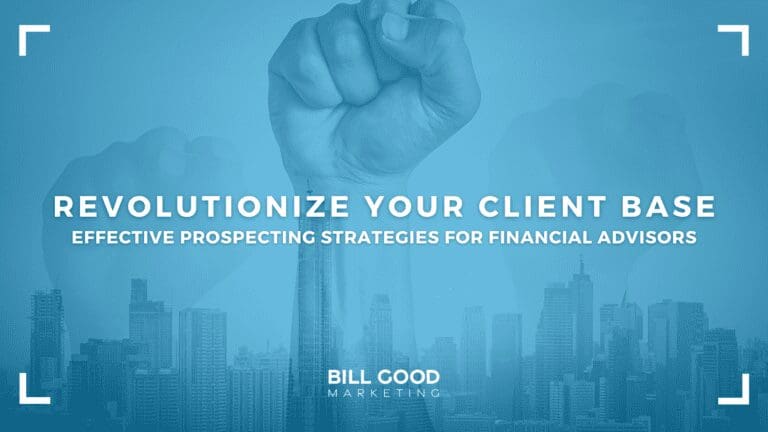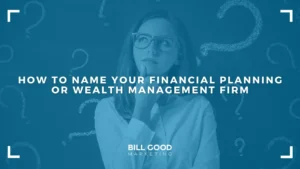Prospecting, the act of identifying, nurturing, and reaching out to potential clients, is a vital skill for financial advisors looking to grow their firm.
Prospecting helps you build a client base—which is essential for the success of your business.
However, reaching out to potential customers and decision-makers can often feel like an uphill battle. Outbound prospecting activities like cold calling and cold emailing can be frustrating and time-consuming, and relying solely on referrals might not be enough to keep your pipeline full. Everyone seems to be turning to social media lately, but you know that too often it’s the luck of the algorithm.
Prospecting is important because it creates opportunities to connect with new prospects and grow your client base. By investing time and resources into prospecting, you can expand your reach beyond existing customers and open up a whole world of new sales potential.
Although it’s mostly used by sales professionals, it’s necessary to at least get basic prospecting skills under your belt (especially if you don’t have a sales team to fill your sales pipeline with qualified leads).
Prospecting is a profitable complement to a larger marketing strategy when done thoughtfully. However, not all prospecting tactics are equally effective, and starting without a strong plan can lead to inefficient or ineffective outreach.
In this article, we’ll explore some sales prospecting techniques that have helped BGM’s consulting clients grow their business.
6 Prospecting Strategies for Financial Advisors
Here are some inbound and outbound prospecting methods that you can use to fill your sales funnel with high-quality sales leads.
1. Content Marketing
Content marketing is a powerful tool for financial advisors. By creating and sharing valuable content, you can attract and engage potential clients, establish your expertise, and build trust with your audience. This could involve writing blog posts, creating videos, hosting webinars, or publishing white papers on relevant financial topics. The key is to provide content that is informative, engaging, and relevant to your target audience.
Content marketing is a popular marketing tool for most businesses. Most businesses pump out content in hopes that it’ll climb high enough up a search engine like Google or get shared among their ideal clients. As a result, there is so much content out there that it’s very hard to stand out from the crowd.
So, let’s be more thoughtful with your content marketing strategy.
- You can start by defining what message you’d like to communicate to your ideal clients. Make sure that your message, whatever it is, supports the one thing you want to communicate: you’re a Trusted Advisor. That is, you have the skills to get them to reach their goals, you’re a caring and well-mannered individual, and you’re a good citizen with a positive impact on the community.
- Know who you’re talking to by building an ideal customer profile. The information you should communicate differs depending on this factor. While a message tailored to one person would be extremely effective, in most cases a 1:1 discussion wouldn’t be as effective in content marketing. Instead, segment your audience and try to get as specific as possible when defining the persona you’re talking to, such as their demographics, occupation, pain points, interests, and account type. The basic segments you’d often encounter would be: clients, prospects, social connections, and audience from mass mail. However, you can narrow your prospecting efforts if you have a more specific buyer persona.
- How often to say it. Stay top of mind by making sure that your clients, prospects, connections, and potential audience hear from you regularly. The frequency depends on your relationship with them. If they’re more familiar with you, you can contact them more frequently. In most cases, all of your audience should hear from you every 90 days.
- Deliver your messages in the right format. There are various channels you can use to relay your messages. You can use handwritten cards, emails, webinars, podcasts, social media posts, and even ads to deliver your message.
The best part about content marketing is that it doesn’t feel like a sales pitch. Instead, it’s an opportunity to show off your knowledge and help potential clients improve their financial literacy.
Content marketing also has the benefit of being shareable. When people find something they find valuable, they’re more likely to share it with their friends and family. So not only will you be reaching your direct audience, but you’ll also be expanding your reach through word of mouth.
2. Social Media Networking
Social media platforms like LinkedIn, Facebook, and Twitter can be powerful tools. Maybe not for prospecting, but having a social media presence helps you spread the word about your values, results, and processes.
Instead of aiming for a wide reach, make sure that you’re itching a very specific type of people. You can connect with potential customers and decision-makers in your industry, creating a powerful network of trusted contacts.
While it’s not a powerful strategy on its own, having a social media presence can support your other strategies. Stay top of mind with your connections by posting regularly or leaving thoughtful comments on your connections’ posts.
Posts with a lot of social impressions are powerful social proof, but posting your insights and opinions can also help you stand out from competitors. One of your values might resonate with your prospects and pique their interest.
3. Hosting Webinars and Seminars
Hosting educational webinars or workshops can be an effective way to attract potential clients. These events provide an opportunity to share your expertise, answer questions, and build relationships with potential clients.
Webinars and workshops provide a platform for interaction. Prospective clients can ask questions and engage in discussions, providing a deeper understanding of their needs and concerns. This interaction can help build relationships and foster a sense of community.
By hosting webinars, you can reach a wider audience beyond your local area, creating a broader reach for your business. Seminars, on the other hand, can also be a valuable tool in your outreach arsenal. Hosting an event in person allows you to make genuine connections with attendees, creating a stronger personal connection that leaves an impression on prospects.
In both cases, it’s important to create engaging and informative content that will resonate with your audience. By taking the time to understand the unique needs of your potential clients, you can tailor your webinars and seminars to provide customized solutions that will help them achieve their financial goals.
4. Client Referral Programs
Word-of-mouth referrals are incredibly valuable as a lead-generation tool. According to a survey by Nielsen in 2021, 88% trust a recommendation from someone they know over any other advertising method.
An effective client referral program starts with providing exceptional service. When clients are satisfied with your services, they are more likely to recommend you to others.
Instead of soliciting referrals and enduring the quiet silence as your client ponders whether they have someone they can refer to you, focus on building a lifelong relationship with your clients—and their heirs and family members.
Make sure that you’re the first person who pops into their mind when someone asks them if they know a good financial advisor—without ever soliciting for a referral.
5. Network with potential clients
Strategic partnerships let you tap into a wider network. By partnering with non-competitive professionals who serve the same clientele, you can refer clients to one another and build a more comprehensive experience for clients as well.
You might partner with CPAs, attorneys, real estate agents, or even financial advisors in other areas—professionals that your clients often need to consult as well.
One of the easiest ways to find these beneficial connections is by asking your clients who their current service providers are, and seeing if you can find mutual connections. It’s not a strange question, as you might have to work with them in the future as well if you’re planning to work with your client for a long while.
However, you need to make sure that the relationship is beneficial for both parties. It’s very easy for a relationship to turn into a one-way street. If you already have an agreement with someone, make sure that both of you are getting something out of the agreement. Make sure that you communicate with them regularly. You might even want to team up for a joint marketing platform, such as hosting a webinar or seminar together.
6. Direct Mail
This is one strategy you need to try if you want to stand out. Instead of a phone call or an email, send a physical letter instead. Personalized letters to potential clients will make a stronger impression than emails.
The key to successful direct mail marketing is to target your audience carefully, personalize your messages, keep the letters free of jargon, and provide a minimal call to action.
You should send at least one letter a month that is relevant to your client’s interests and needs. This is what we call the Monthly Drip—which is just one letter sent to make the reader feel something, provide them with valuable insights, or a little bit of both.
Even if you don’t know what to say in a letter, Bill Good Marketing has over 2,500 templates that you can use in any situation to engage, enlighten, and encourage your readers. Send letters for special events—such as birthdays and national holidays—letters to build connections, or current events.
Measuring the Success of Your Prospecting Strategies
By measuring your success, you can identify which strategies are working, which ones need improvement, and where to focus your efforts in the future.
Key metrics to track might include the number of new clients acquired, the conversion rate of prospects to clients, and the return on investment (ROI) of your marketing efforts. For example, if you’re using content marketing as a prospecting strategy, you might track metrics like website traffic, blog post views, and the number of new clients acquired through your content.
Analyzing these metrics can provide valuable insights into the effectiveness of your prospecting strategies. For instance, a high conversion rate might indicate that your content is resonating with your audience, and a low ROI might suggest that you need to optimize your marketing spend.
There are various tools and techniques available to help you measure your prospecting success.
Customer relationship management (CRM) systems can track interactions and discover opportunities from potential buyers and current clients. With the help of a CRM system, and some email templates, you can also automate most tasks in your sales process, such as follow-up emails or a targeted campaign.
While analytics tools can provide insights into website traffic and user behavior, surveys and feedback forms can also be useful for understanding the needs and preferences of your
Find New Ideal Clients with The Help of Bill Good Marketing
Prospecting isn’t a skill exclusive to sales reps. Salespeople do this day in and day out, so it’s natural that they’ll do a better job of closing clients. However, with a marketing engine in place, you can fill your pipeline with new leads every day—even if you haven’t mastered the sales prospecting process most people use.
The trick is discovering which sales prospecting strategy will work for you.
The good news is, we’ve cracked the code for you after decades of growing financial advisory firms like yours – and wrote the playbook too.
Get ready-to-implement workflows so you can get more qualified leads through the door. Learn more about the prospecting machine we’ve built that led our clients to $19.8M in new AUM last year.




